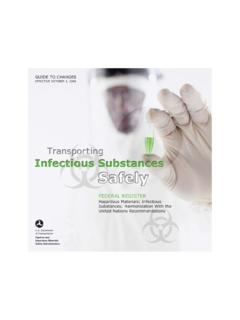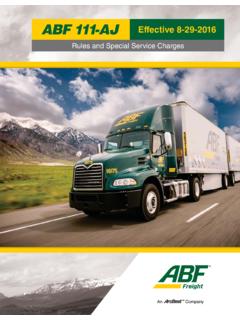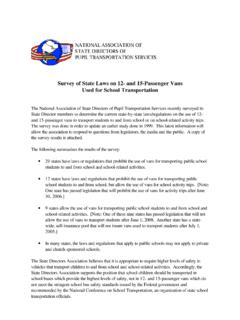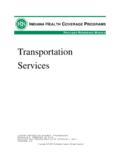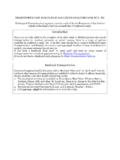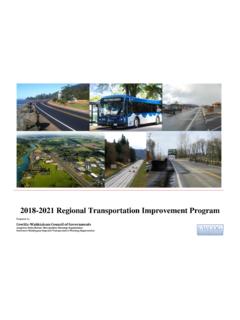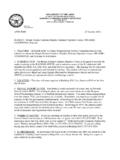Transcription of HAZARDOUS MATERIALS TRANSPORTATION MOTs Video …
1 HAZARDOUS MATERIALS TRANSPORTATIONC ompliance Basics Department of TransportationPipeline and HAZARDOUS MaterialsSafety AdministrationWhat are the Packaging and Marking Requirements for MOTs? MATERIALS of Trade also have packagingand marking requirements that helpincrease safety. The packaging must be themanufacturer s original packaging or apackage of equal or greater strength andintegrity. The packaging must be markedwith a common name (such as gas or spray paint ) or a proper shipping namefrom the HMR (such as Isopropyl Alcohol .)Additionally, the following otherrequirements apply to MOTs: Packagings must be leak tight for liquids andgases, and sift proof for solids. Packages must be securely closed, securedagainst movement, and protected againstdamage.
2 Outer packagings are not required forreceptacles (such as cans or bottles) that aresecured against movement in cages, bins,boxes, or compartments. Gasoline must be transported in a metal orplastic container meeting DOT or OSHA requirements (Section (b) (4) andSection in the HMR). Cylinders and pressure vessels must conformto the HMR except that outer packagings arenot required. These cylinders must bemarked with the proper shipping name andidentification number and have a hazardclass warning label. If the package contains a reportable quantityof a HAZARDOUS substance, it must be marked RQ . Reportable quantities are found inAppendix A of Section in the HMR. A tank containing a diluted mixture (notmore than 2% concentration) of a Class 9material must be marked on two opposingsides with the identification Video Available from thePipeline and HazardousMaterials Safety AdministrationTo help you better understand MATERIALS ofTrade regulations, PHMSA has developed aninformative Video titled UnderstandingMaterials of Trade Regulations.
3 The videodefines MATERIALS of Trade; discusses whathazardous MATERIALS may be transported asMOTs; and provides an overview of whathazardous MATERIALS regulations apply. It isavailable from PHMSA s Office of HazardousMaterials Initiatives and Training for ashipping and handling fee of $10. The Understanding MATERIALS of TradeRegulations Video can be ordered on-line byvisiting our web site at: ; by e-mail: or byfilling out the form below and faxing it to:(202) 366-7342, or mailing it to the addressindicated at the bottom of the send ____ Understanding MATERIALS ofTrade Regulations Video (s) to:Name:Company:Address:City:State/Zip:P hone:FAX:E-Mail:$10 (each Video ) covers shipping card #:Expiration date:Signature:We accept:or personal checks made payable to:USDOT/PHMSA/PHH-50 PHMSA Hazmat Safety HomepageTo learn more, visit the PHMSA HazmatSafety Homepage on the Internet, There, you can order training CD-ROMs, videotapes, and publications.
4 You can also view ordownload the HMR, copies of the latestrulemakings, exemptions, clarifications of regulations, HAZARDOUS materialspublications, and training Department of TransportationPipeline and HAZARDOUS MaterialsSafety Administration400 Seventh Street, SW, PHH-50 Washington, DC 20590E-Mail: AHAZMATQUESTION?PHH50-0062-0905 Whether you are self-employedor work for a large company,you may be carrying hazardousmaterials as part of your job. A hazardousmaterial is a substance or material which has been determined by the of TRANSPORTATION (DOT) to becapable of posing an unreasonable risk tohealth, safety, and property whentransported in commerce. This definitionis found in the requirements fortransporting HAZARDOUS MATERIALS knownas the HAZARDOUS MATERIALS Regulations(HMR), issued by DOT s Pipeline andHazardous MATERIALS Safety Administration(PHMSA.)
5 The HMR tell you: how to classify and package hazardousmaterials; how the package must be marked andlabeled; how to complete shipping papers; how to provide required emergencyresponse information; whether the vehicle transportinghazardous MATERIALS must be placardedand the specific placards required; and what training is required for handlersand shippers of HAZARDOUS HMR are published in Title 49, Codeof Federal Regulations (49 CFR), HAZARDOUS MATERIALS transportedin small quantities as part of a businessare subject to less regulation, because ofthe limited hazard they pose. Thesematerials are known as MATERIALS of hazard that is, if it belongs toPacking Group II or III, other than , or is a consumer commodity (ORM-D) the maximum amount of material ineach package is 30 kg (66 lbs) for solids,or 30 L (8 gal) for liquids.
6 For Division MATERIALS (only PackingGroup II and III MATERIALS are allowed) themaximum amount of material in eachpackage is 30 ml (one oz.) Each cylinder containing a gas ( or ) may not weigh more than 100kg (220 lbs.) A diluted mixture of a Class 9 material (not exceeding 2% concentration) may betransported in a tank having a capacity ofup to 1500 L (400 gal.)What Are MATERIALS of Trade,and What Regulations Apply? MATERIALS of Trade (MOTs) are hazardousmaterials, other than HAZARDOUS waste, thatare carried on a motor vehicle: to protect the health and safety of themotor vehicle operator or passengers,such as insect repellant or a fireextinguisher; to support the operation or maintenanceof a motor vehicle (including its auxiliaryequipment), such as a spare battery orgasoline.
7 Or to directly support a principal business ofa private motor carrier (including vehiclesoperated by a rail carrier) that is otherthan TRANSPORTATION by motor vehicle forexample, landscaping, pest control,painting, plumbing, or welding aware that it is your responsibility toknow if you are transporting a hazardousmaterial and the requirements in the HMRthat regulations that apply to MOTs arefound in 49 CFR Section Theyinclude: general knowledge of MOTs regulations; quantity limitations; packaging requirements; and marking and labeling MOTs regulations do not require: shipping papers; emergency response information; placarding; or formal training or retention of Quantity Limits Apply forHazardous MATERIALS beingTransported as MOTs?
8 With the exception of tanks containingdiluted mixtures of Class 9 MATERIALS , nomore than a combined gross weight of 200kg (440 lbs) of MATERIALS of Trade can betransported on any one vehicle. Size limitsfor individual packages apply to MATERIALS ofTrade as described below: If a HAZARDOUS material is a high-hazardmaterial (Packing Group I), the maximumamount of material in one package is kg(one lb) for solids, or L (one pt) forliquids. If the HAZARDOUS material is a medium orWhat HAZARDOUS MATERIALS Qualify as MOTs?To be a material of Trade, the HAZARDOUS material must fit into any one of the following classesor divisions:Class or DivisionExamplesFlammable Gases (Division )acetylene, propaneNon-flammable Gases (Division )oxygen, nitrogenFlammable or Combustible Liquids (Class 3)paint, paint thinner, gasolineFlammable Solids (Division )charcoalDangerous When Wet MATERIALS (Division )some fumigantsOxidizers (Division )bleaching compoundsOrganic Peroxides (Division )benzoyl peroxidePoisons (Division )pesticidesSome Infectious Substances (Division )diagnostic specimensCorrosive MATERIALS (Class 8)muriatic acid, drain cleaners, battery acidMiscellaneous HAZARDOUS MATERIALS (Class 9)asbestos, self-inflating lifeboatsConsumer Commodities (ORM-D)hair spray, spray paints

